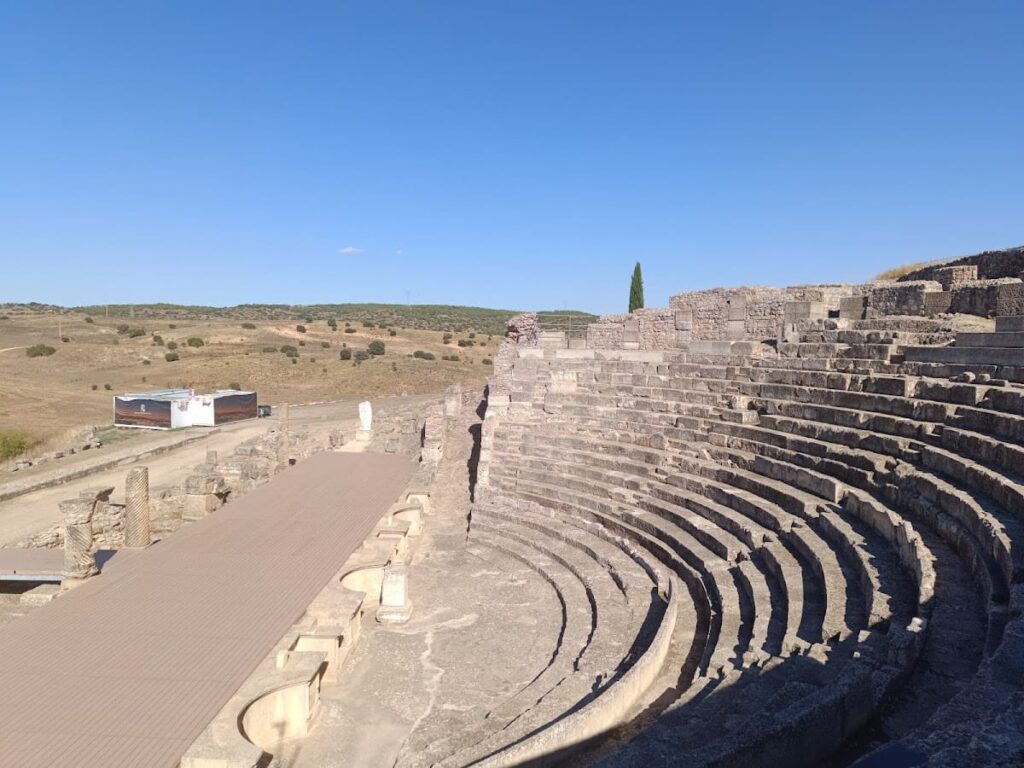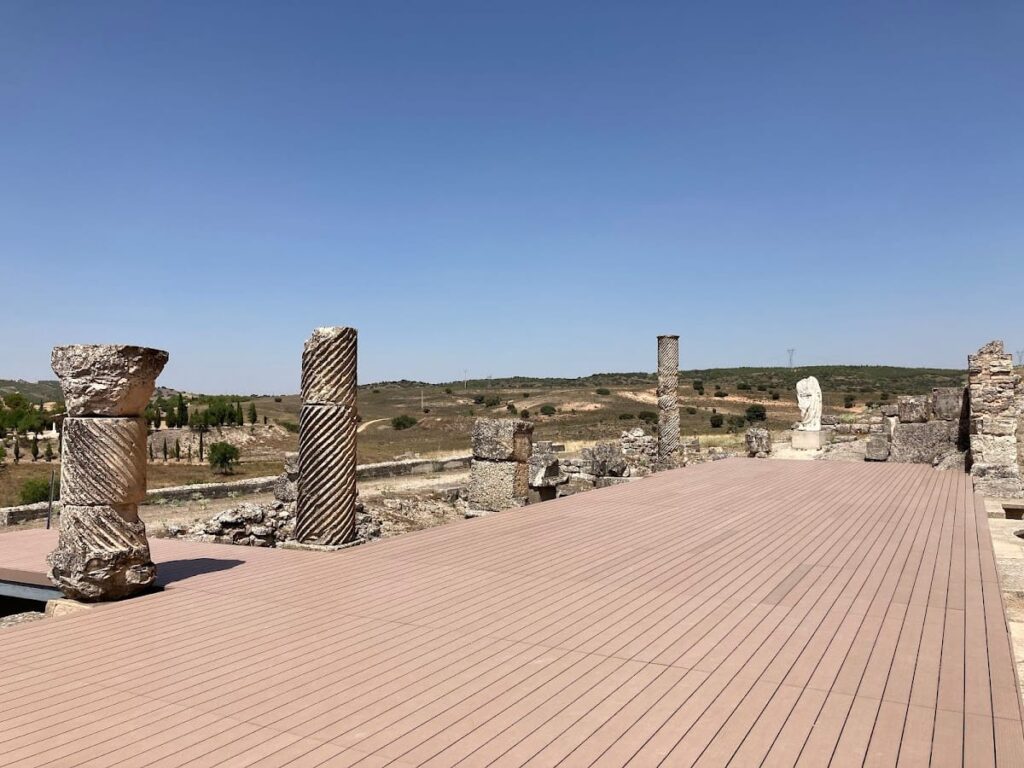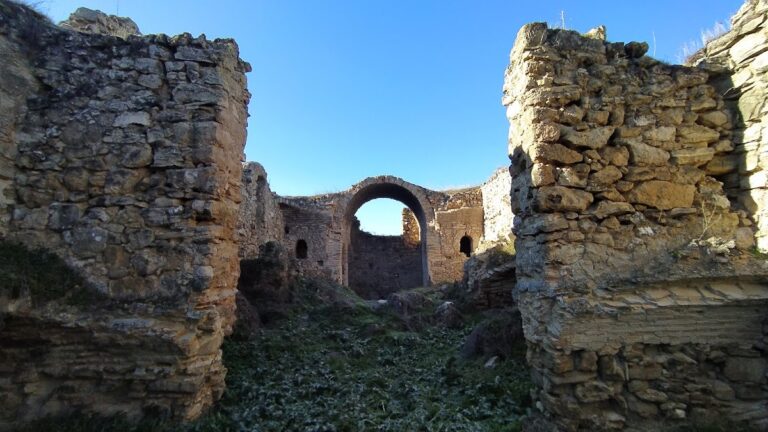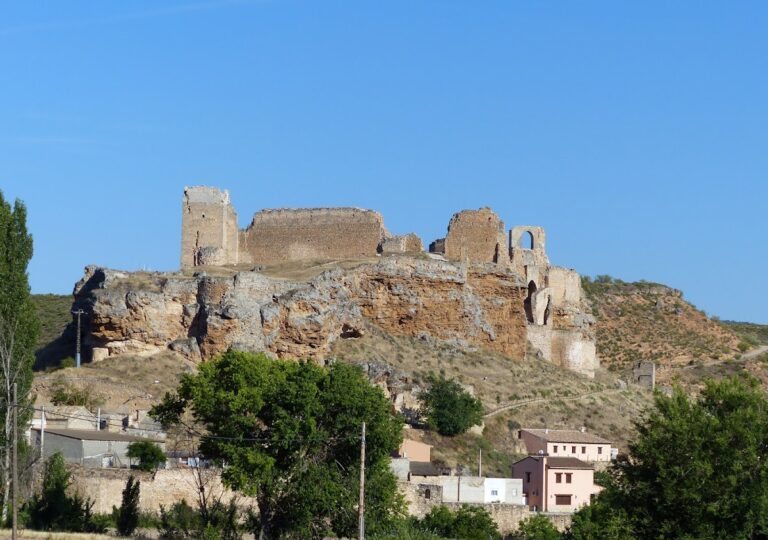Segóbriga Archaeological Park: An Ancient Roman Municipium in Spain
Table of Contents
Visitor Information
Google Rating: 4.6
Popularity: Medium
Google Maps: View on Google Maps
Official Website: www.segobriga.org
Country: Spain
Civilization: Roman
Remains: City
Context
Segóbriga Archaeological Park is situated atop a limestone plateau near the modern town of Saelices in the province of Cuenca, within the autonomous community of Castilla‑La Mancha, Spain. The elevated position overlooks the surrounding agricultural plains and river valleys characteristic of the central Iberian Meseta, providing natural defensive advantages that influenced its selection as a settlement site. The local geology, dominated by limestone formations, supplied building materials and shaped land use patterns in the vicinity.
Archaeological investigations have documented continuous human occupation at Segóbriga from the Bronze Age through Late Antiquity. Early layers reveal Celtiberian cultural elements, while subsequent Roman conquest and provincial integration transformed the site into a municipium with significant urban development. Material culture and inscriptions attest to sustained habitation and administrative functions into the later Roman and Visigothic periods. Stratigraphic evidence indicates a gradual decline and abandonment prior to the medieval era.
Systematic archaeological research, initiated in the nineteenth century and intensified in the twentieth, has uncovered well-preserved urban layouts and monumental architecture. The site is protected under Spanish heritage legislation and managed as an archaeological park, facilitating ongoing study and conservation of its extensive remains.
History
Segóbriga’s historical trajectory spans from prehistoric occupation through the early medieval period, reflecting broader cultural and political transformations in the Iberian Peninsula. Its location in the heart of the Meseta Central positioned it as a strategic and administrative center during successive phases of indigenous, Roman, Visigothic, and early Islamic control. The site’s evolution illustrates the processes of Romanization, urbanization, and later decline characteristic of many settlements in Hispania.
Bronze Age and Celtiberian Settlement
Archaeological evidence near Segóbriga indicates human presence dating back to the Bronze Age, approximately the 2nd millennium BCE. Excavations in the limestone cave known as Cueva de Segóbriga, located near the Cerro de Cabeza de Griego, uncovered collective burials containing human remains and associated domestic tools, demonstrating early ritual and habitation activities. By the Iron Age, the area was occupied by a Celtiberian castro—a fortified settlement—commanding the basin north of the later Roman city. Although no structural remains of this fortification have been identified, the discovery of a 5th-century BCE Attic pottery fragment confirms occupation during this period.
The toponym “Segóbriga” derives from Celtiberian linguistic roots, combining “Sego-” meaning “victory” and “-briga” meaning “fortress” or “city,” thus signifying “Victorious Fortress.” This nomenclature reflects the settlement’s early military and political significance within the Celtiberian cultural landscape.
Roman Conquest and Administration (2nd century BCE – 1st century CE)
During the early 2nd century BCE, Roman forces incorporated Segóbriga into their expanding provincial system amid the Celtiberian Wars. The settlement was transformed into a Roman oppidum, serving as a local administrative center. The city’s strategic importance is documented in the context of the Sertorian Wars (circa 80–72 BCE), during which it functioned as a regional hub controlling a substantial territory within the Meseta Central. Ancient sources, including the Greek geographer Strabo, reference Segóbriga in relation to military conflicts involving Roman commanders Quintus Caecilius Metellus Pius and the rebel Sertorius.
In the 2nd century BCE, the Lusitanian leader Viriathus launched two recorded attacks on Segóbriga, as noted by Sextus Julius Frontinus, motivated by the city’s alliance with Rome. By the 1st century BCE, Pliny the Elder identified Segóbriga as a stipendiary city within the Caesaraugustan Conventus and designated it “caput Celtiberiae,” marking it as a cultural and administrative boundary between Celtiberian and Carpetani peoples. The surrounding region was economically significant for the extraction of lapis specularis, a translucent gypsum used in window glass manufacture, mined extensively within a radius of approximately 100,000 steps from the city, notably near Carrascosa del Campo. This resource contributed substantially to the local economy during this period.
Imperial Roman Period (1st–3rd centuries CE)
Under Emperor Augustus, around 12 BCE, Segóbriga was elevated from a tributary settlement to municipium status, conferring Roman citizenship and self-governance upon its inhabitants. This legal advancement stimulated urban growth and social development. A significant construction phase occurred during the Flavian dynasty, culminating circa 79 CE with the completion of monumental public buildings. These included a theater, initiated under Tiberius and completed under Vespasian, and an elliptical amphitheater approximately 75 meters in length, capable of seating around 5,500 spectators. Defensive city walls with a prominent northern gate were also erected during this period.
Segóbriga functioned as a regional communications node and minted its own coinage, reflecting economic autonomy and integration within the imperial system. Additional infrastructure from this era comprises monumental baths, a gymnasium adjacent to the theater, a forum serving as the civic center, an acropolis area, and a rock sanctuary dedicated to the goddess Diana located outside the city walls. The city was supplied with water via an aqueduct originating near present-day Saelices. Quarries outside the urban perimeter provided building materials. An unfinished circus, constructed over a preexisting necropolis, indicates ambitious urban planning that was never completed. Archaeological evidence attests to the continued residence of elite families into the 3rd century CE.
Late Antiquity and Decline (4th century CE)
By the 4th century CE, Segóbriga experienced a marked decline consistent with broader trends in Roman Hispania. Many principal monuments were abandoned, and the urban center gradually transitioned into a more rural settlement. This transformation reflects socio-economic shifts affecting the western provinces of the Roman Empire, including population contraction and reduced civic investment. The city’s infrastructure and monumental architecture fell into disuse, signaling diminished administrative and social functions.
Visigothic Period (5th–8th centuries CE)
Despite earlier decline, Segóbriga retained significance as an urban and ecclesiastical center during the Visigothic era. Excavations have revealed several basilicas and an extensive necropolis dating from this period. The city’s bishops participated in prominent ecclesiastical councils, including the Third Council of Toledo in 589 CE and the Sixteenth Council of Toledo in 693 CE, underscoring its continued religious and administrative importance. The Basilica of Cabeza de Griego, constructed outside the city walls, exemplifies early medieval Christian architecture and the persistence of Christian worship in the area.
Early Medieval and Islamic Period (8th–11th centuries CE)
Following the Muslim conquest of the Iberian Peninsula in the early 8th century, Segóbriga underwent significant depopulation as its Christian elites, including bishops, fled northward to emerging Christian kingdoms. This pattern paralleled that of nearby urban centers such as Ercávica. Archaeological remains of a Muslim fortress atop the Cerro de Cabeza de Griego demonstrate the site’s continued strategic military use under Islamic governance, although the urban core itself diminished in prominence and population during this period.
Post-Reconquista and Medieval Abandonment (12th century onward)
After the Christian Reconquista, the local population relocated approximately three kilometers north to establish the modern town of Saelices, situated near the spring that historically supplied water to Segóbriga via its aqueduct. The original site’s name gradually fell out of use, with the hill becoming known as “Cabeza del Griego.” A small rural community dependent on the nearby town of Uclés occupied the area. Stones from Segóbriga’s ruins were repurposed for construction projects, notably the Uclés convent-fortress. Over time, the ancient city was largely abandoned, with only a small hermitage built atop the remains of the Roman baths surviving as a vestige of its former urban character.
Daily Life and Importance by Period
Roman Conquest and Administration (2nd century BCE – 1st century CE)
During the transition from Celtiberian to Roman control, Segóbriga’s population comprised indigenous inhabitants alongside Roman settlers and officials. Social stratification is evidenced by inscriptions referencing municipal magistrates such as duumviri, indicating organized local governance. The economy combined agriculture with industrial-scale extraction of lapis specularis gypsum, mined in the surrounding region for window glass production. Markets and workshops likely facilitated trade in agricultural and manufactured goods. Dietary remains suggest consumption of bread, olives, and freshwater fish, consistent with regional patterns. Religious practices reflected a syncretism of indigenous and Roman cults, with early temples and sanctuaries dedicated to local and imperial deities. The settlement’s role as a regional administrative center was reinforced during the Sertorian Wars and subsequent Roman consolidation.
Imperial Roman Period (1st–3rd centuries CE)
Following its elevation to municipium, Segóbriga experienced urban expansion and social advancement. The population included Roman citizens, local elites, artisans, and laborers, with civic life organized around magistracies and a city council, as attested by epigraphic evidence. Economic activities diversified to include artisanal production such as pottery, textiles, and metalwork, supporting both local consumption and regional trade. The city minted its own coins, reflecting economic integration within the empire. Archaeological findings reveal affluent domestic interiors with mosaic floors and painted plaster. Diet was varied, incorporating cereals, olives, legumes, and occasional meat and fish. Public amenities such as baths and a gymnasium facilitated social interaction and hygiene. Markets convened in the forum, where residents acquired foodstuffs and luxury items transported via Roman roads. Religious life encompassed temples, a sanctuary to Diana, and imperial cult worship. The theater and amphitheater hosted cultural and social events, reinforcing civic identity and Roman cultural norms.
Late Antiquity and Decline (4th century CE)
By the 4th century, Segóbriga’s urban vitality diminished as population declined and monumental structures fell into disuse. The social hierarchy contracted, with fewer elite families maintaining residences, while the majority adapted to a more rural lifestyle. Economic activities shifted toward subsistence agriculture and small-scale craft production, reflecting reduced regional trade. Domestic spaces became simpler, with less investment in decoration. Markets persisted at a smaller scale, serving the needs of a contracting population. Transport activity decreased in frequency and scale. Religious practice transitioned increasingly toward Christianity, with pagan temples abandoned or repurposed. The city’s administrative role waned, and civic institutions lost prominence, mirroring broader patterns of urban contraction in Late Roman Hispania.
Visigothic Period (5th–8th centuries CE)
During Visigothic rule, Segóbriga maintained its status as a religious center. The population included Christian clergy, local inhabitants, and possibly residual Romanized elites. Ecclesiastical leadership was prominent, with bishops participating in major councils such as those held in Toledo. Economic life focused on agriculture and funerary services associated with the extensive necropolis. Craft production and trade were limited but sufficient to sustain the community. Domestic architecture adapted to simpler forms, with basilicas constructed outside the former city walls, including the Basilica of Cabeza de Griego. Christian worship dominated social life, with liturgical activities and religious festivals central to the community. The city’s civic role shifted from municipal governance to ecclesiastical administration, reflecting the Visigothic kingdom’s political structure.
Early Medieval and Islamic Period (8th–11th centuries CE)
Following the Muslim conquest, Segóbriga experienced significant depopulation as Christian elites fled northward, leading to contraction of urban life. The remaining population was sparse, with the site’s strategic importance maintained primarily through the Muslim fortress atop Cerro de Cabeza de Griego. Economic activities were minimal, focused on sustaining the garrison and small local communities. Residential structures were limited, and domestic life was modest. Trade and markets largely disappeared, replaced by military and administrative functions under Islamic governance. Religious practices shifted with the introduction of Islam, though archaeological evidence for mosques or religious buildings within the urban core is limited. The fortress’s presence indicates continued strategic control rather than civic or economic prominence.
Post-Reconquista and Medieval Abandonment (12th century onward)
After Christian forces reconquered the region, the population relocated approximately three kilometers north to establish the modern town of Saelices, near the aqueduct’s water source. The original urban fabric was abandoned, and the site’s name faded from common use. Economic life centered on rural agriculture supporting the new settlement and the nearby town of Uclés. Stones from Segóbriga’s ruins were repurposed for construction projects, including the Uclés convent-fortress, indicating the site’s material legacy persisted regionally. Domestic and civic structures fell into ruin, with only a small hermitage atop the former Roman baths surviving as a vestige of earlier urban life. The area functioned as a sparsely inhabited rural landscape dependent on neighboring towns, marking the end of Segóbriga’s historical urban significance.
Remains
Architectural Features
Segóbriga’s archaeological remains occupy a limestone plateau, with construction predominantly utilizing locally quarried limestone blocks. The urban layout is characterized by a fortified enclosure with defensive walls dating to the 1st century CE, enclosing a compact city plan. The architecture reflects a combination of civic, religious, and leisure functions, with monumental public buildings concentrated near the city center and quarries located beyond the walls. The city underwent significant expansion during the Flavian period (late 1st century CE), when many of its principal structures were erected. Over subsequent centuries, the urban area contracted, with some buildings repurposed during the Visigothic and early Islamic periods. Surviving remains include foundations, partial walls, and structural elements of major public edifices, while some sectors remain fragmentary or unexcavated.
Key Buildings and Structures
Amphitheatre
The amphitheatre, completed by the end of Emperor Vespasian’s reign in the late 1st century CE, is the largest monument at Segóbriga. It has an elliptical plan approximately 75 meters in length and is situated opposite the theater within the archaeological complex. The structure could accommodate an estimated 5,500 spectators. Stone foundations and seating tiers remain partially preserved, delineating the arena and spectator zones. The amphitheatre’s design incorporates typical Roman features, including tiered seating arranged to reflect social stratification, although detailed internal architectural elements are fragmentary.
Theatre
Construction of the theater began under Emperor Tiberius and was completed around 79 CE during Vespasian’s rule. Positioned facing the amphitheatre, the semicircular seating area (cavea) is well preserved and divided into three horizontal sections, corresponding to social class distinctions among the audience. The stone construction includes remains of the stage building and seating tiers. The theater formed part of a public leisure complex that also comprised adjacent baths and a gymnasium. Its layout and materials are consistent with Flavian-era Roman theaters.
Monumental Baths (Thermae)
The large public baths, dating to the 1st century CE, are located within the city walls. The complex includes multiple rooms typical of Roman baths, such as heated chambers (caldaria) and cold pools (frigidaria), though many internal features are fragmentary. A small hermitage was later constructed atop the bath remains, representing the last standing structure directly over the ancient city. The baths were supplied with water by the city’s aqueduct, which drew from a spring near modern Saelices.
Gymnasium and Baths near the Theatre
Adjacent to the theater is a complex comprising a gymnasium and additional baths, also dating to the 1st century CE. These facilities served as public spaces for exercise and hygiene. The gymnasium includes open and enclosed areas, while the baths feature architectural elements such as hypocaust heating systems (underfloor heating). The remains consist of stone foundations and partial wall structures.
Forum
The forum, constructed during the Flavian period in the late 1st century CE, served as the city’s principal civic space. Excavations have revealed a paved plaza surrounded by porticoes. Stone foundations of administrative buildings and public offices are visible. The forum’s rectangular plan aligns with typical Roman municipal centers, exhibiting ashlar masonry and evidence of organized urban planning.
City Walls and North Gate
The city was enclosed by defensive walls built around 80 CE during the Flavian dynasty. Surviving sections include portions of the limestone walls and the northern gate, which features a preserved entrance passage. The fortifications incorporated towers and battlements, though many sections are now fragmentary. The walls correspond with the city’s elevation to municipium status under Augustus and were completed in the late 1st century CE.
Acropolis
The acropolis occupies a prominent position within the city’s layout. While specific structures on the acropolis remain insufficiently excavated, foundations and terraces indicate its use as a fortified or administrative sector integrated into the urban plan. Detailed architectural remains beyond foundational elements are limited.
Rock Sanctuary of Diana
Located outside the city walls, the rock sanctuary dedicated to the goddess Diana comprises carved stone altars and ritual spaces. Dating to the Roman period, the sanctuary includes rock-cut features and small architectural elements situated on a natural limestone outcrop, indicating religious use beyond the urban core.
Aqueduct
The aqueduct, constructed in the 1st century CE, supplied water to Segóbriga, including the baths and public fountains. Its remains lie outside the city walls, tracing a route from a spring near present-day Saelices, approximately three kilometers north. Stone channels and masonry supports survive in sections, demonstrating Roman hydraulic engineering adapted to local topography.
Quarries
Several quarries located outside the city walls provided limestone for construction. These open-air extraction sites exhibit tool marks and debris fields indicative of systematic stone removal. The quarries are situated near the aqueduct’s source and were essential for supplying building materials during the city’s major construction phases.
Circus
The circus, situated outside the city walls, was intended for chariot racing or similar public spectacles but was never completed. Archaeological investigations revealed that its construction overlapped a preexisting necropolis. The circus’s stone foundations and partial seating areas remain visible, though the structure lacks finishing elements such as the central spine (spina) or complete stands.
Necropolis
The necropolis lies outside the city walls and spans from the Celtiberian period through Roman and Visigothic times. Excavations conducted in the 18th century uncovered numerous tombs and funerary monuments, including inhumations and cremations accompanied by grave goods such as pottery and personal items. The burial area extends over a broad zone surrounding the city’s perimeter.
Basilica of Cabeza de Griego
This Visigothic basilica, constructed from the 5th century CE onward, is located outside the city walls on the Cerro de Cabeza de Griego. The remains include stone foundations and partial wall segments outlining a nave and side aisles. The basilica served as a Christian religious center during the Visigothic period, with bishops from Segóbriga attending councils in Toledo. Its architectural features reflect early medieval ecclesiastical design.
Muslim Fortress
Atop the Cerro de Cabeza de Griego are the remains of a Muslim fortress dating from the 8th century CE or later. The fortification includes stone walls and defensive structures adapted to the hilltop position. This fortress represents the site’s continued strategic use during early Islamic rule, distinct from the Roman urban core.
Other Remains
The original Celtiberian fortified village (castro) north of the city has not been archaeologically identified, but a 5th-century BCE Attic ceramic fragment confirms early occupation. The nearby Cueva de Segóbriga is a Bronze Age collective burial cave excavated in limestone, yielding human remains and tools. Surface remains across the site include traces of the urban street grid and unexcavated building foundations, indicating further archaeological potential.
Archaeological Discoveries
Excavations at Segóbriga have yielded a diverse assemblage of artifacts spanning from the Bronze Age through the early medieval period. These include Celtiberian ceramics, Roman tableware, and amphorae associated with trade and daily use. Inscriptions on stone blocks and altars provide dedicatory texts and municipal information, including references to the city’s status and religious dedications. Coins minted locally during the Flavian and later Roman periods illustrate economic activity and imperial connections. Tools related to agriculture and craft production have been recovered from domestic and workshop contexts. Religious artifacts include statuettes and altars from the sanctuary of Diana and the Visigothic basilica.
Preservation and Current Status
Several structures at Segóbriga are well preserved, notably the theater’s seating, the amphitheatre’s foundations, and sections of the city walls and northern gate. The monumental baths survive in partial form, with the later hermitage built atop them still standing. Other buildings, such as the forum and gymnasium, are preserved mainly as foundations and low walls. The Muslim fortress and Visigothic basilica remain as fragmentary ruins. Conservation efforts have stabilized many exposed remains, with some restoration employing original materials. The site has been protected as a National Monument since 1931 under Spanish heritage laws. Environmental threats have been mitigated, including the relocation of a proposed wind farm project near the site. Archaeological research and preservation continue under local heritage authorities.
Unexcavated Areas
Several parts of Segóbriga remain unexcavated or only partially studied. The acropolis area lacks detailed excavation, and surface surveys suggest additional buried structures within the city’s perimeter. The original Celtiberian castro north of the city has not been located archaeologically. Some urban sectors and peripheral buildings await further investigation, though conservation policies limit extensive excavation to preserve the site’s integrity.










